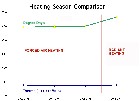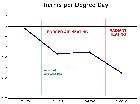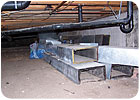
Winter hits a nice, warm radiant house.
Ask anybody in the radiant floor heating business, and they will tell you radiant floor heating can save energy. Unfortunately, ask anybody in the radiant floor heating business, and they will tell you hard data on actual energy savings is hard to come by.
We can certainly draw an easy, fair conclusion between a specific boiler’s efficiency to a specific furnace’s efficiency by comparing the Department of Energy’s Annual Fuel Utilization Efficiency (AFUE) rating. But radiant heating is more than just a heat-generating system, it’s also a heat distribution method. Just how can you compare water pipes in the floor to hot air ductwork and registers?
To complicate matters even further, people don’t react to the various heat delivery systems in the same way. Left to their own comfort choices, people will set their thermostats differently in a radiant system than they will in a forced air environment. They will live differently in the space as well, frequenting different parts of the house more often depending on the heat delivery system. Add on top of that the variations in building construction and design, and how the heat delivery systems react to the building envelope, and an apples-to-apples comparison becomes difficult at best.
So what is the answer to acquiring hard data to substantiate the common claims that radiant heating is more energy-efficient than forced air? A single test chamber or test house will only provide data for that particular configuration. In fact, a number of those types of studies have been done over the past 50 years with varying results.
What’s needed is a large number and a wide variety of buildings to build a reasonably comparative database. I believe the Radiant Panel Association has the ability to do just that through its members. By providing a data collection point, we can build a database of structures that have been converted from conventional heating to radiant heating, buildings that have a history of before and after. With enough input, we can make reasonable comparisons and draw substantiated conclusions.

The
Quietside 90 percent AFUE-rated boiler that was installed with the radiant
heating system.
My Own Data
What convinced me that this scenario is possible was the retrofit and subsequent data collected on my own home. In the summer of 2006, I removed the entire forced-air heating system and replaced it with a radiant floor heating system. We had purchased the 30-year-old home on a crawl space four years ago with the intent of converting it to radiant. After living in homes with radiant heat for 20 years, it meant moving back into forced air for a while. As with most projects, it took several years longer to get around to it than I had expected.
Figure 1: After the radiant floor installation, energy use remained the same even though a much colder winter was experienced.
In doing a comparison of this sort, you cannot simply compare this year’s utility bills with last year’s or the year before. Obviously, annual weather plays a big part in how much energy is used.
The best yardstick we have for weather is the “degree day.” Degree days are tracked by the National Climatic Data Center and are reported for most cities in the United States. (For a free report, visitwww.EnergyCAP.com.) A degree day is defined as a “deviation of one degree temperature for one day from an arbitrary standard, usually the long-term average temperature for a place.”
ASHRAE uses 65 degrees F as the outside temperature below which a structure will require heat. In other words, if we use the ASHRAE-specified 65 degrees F, and the average temperature of a particular winter’s day is 10 degrees F, the difference would be 55 degrees, or 55 degree days. The colder it is, the more degree days. We can add up all the degree days for a winter and compare them to the degree days of the same period for a previous winter.
I tracked degree days from October through March over four years. As you can see by Figure 1, last winter was significantly colder (more degree days) than the three previous winters, but the amount of gas in “therms” used was about the same. A therm is equal to 100,000 Btus. This is a utility company’s measurement for gas used.

Figure 2: A substantial drop in energy use can be seen after the forced-air system was replaced with a radiant system.
But the picture the chart paints needed some adjustment to make it accurate. Figure 3 illustrates what happened to the electric utility use, since the new boiler now heats the domestic hot water originally handled with an electric water heater. Since Figure 2 initially reflected all gas used, the energy expended on heating domestic hot water in 2006-2007 was subtracted from the total to reflect the actual amount of gas used for space heating alone.

Figure 3: The new gas boiler also picked up the domestic water heating load from the old electric water heater as seen in this chart.
What could be significant is the change in the heating plant itself. If we had replaced an old, standing pilot light, naturally ventilated furnace with a new, high-efficiency condensing boiler; that alone could account for the savings. As it is, the removed furnace was a five-year-old, high-efficiency, fully condensing unit with insulated ductwork. The 92 percent AFUE rating on the Amana furnace is very nearly the same as 90 percent AFUE rating on the new Quietside boiler that now hangs on the wall. Had there been a significant difference, those differences could have been calculated and taken into consideration.
As it stands, I can say with a high degree of confidence that the installation of a radiant heat distribution system accounts for the energy savings.

The 4-zone module.
Savings
You may be thinking that 9 percent is not a lot of savings, but consider this: When living with forced air and a single thermostat, the only warm place in the house was the living room nearest the thermostat.The back rooms were always chilly to cold. The master bathroom was as much as 10 degrees colder than the living room. The great room, where we spend most of our time, has three outside walls, a fireplace and lots of windows. It was always cold, no matter where the thermostat was set. The bed in the guest room was piled high with blankets to keep our visitors warm.

The ductwork removed from the crawlspace.
Not only that, but I also installed gas logs in the original wood-burning fireplace. Now we sit watching the flames dance over ceramic logs while 80 percent of that heat goes up the chimney. That’s about 60,000 Btus per hour wasted up the stack just to add a nice ambience to the family room on a snowy day. We gain the warmth, comfort and aesthetics and still save 9 percent. Not a bad deal.

Heat transfer plates applied to the underside of
the subfloor in the crawl space.
The RPA will compile the information, input the appropriate degree day data and perform the necessary calculations. The result will be an energy comparison for each structure. The results will be fed back to the submitting contractor and included in a growing database on the RPA Web site. The database will be made available to RPA members and summarized for use in the trade and consumer press.
It starts with a single home, but with each building added, more knowledge will be gained. As this program grows with acquired data, confidence in the radiant heating industry also will grow. This could be just the tool the industry has been asking for to confirm what we have experienced and know to be true.

